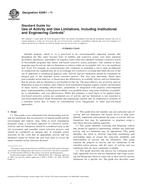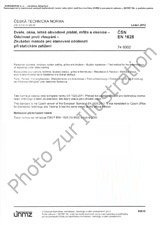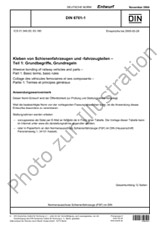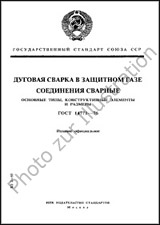Wir benötigen Ihre Einwilligung zur Verwendung der einzelnen Daten, damit Sie unter anderem Informationen zu Ihren Interessen einsehen können. Klicken Sie auf "OK", um Ihre Zustimmung zu erteilen.
ASTM E2091-11
Standard Guide for Use of Activity and Use Limitations, Including Institutional and Engineering Controls
Automatische name übersetzung:
Standard-Leitfaden für den Einsatz von Aktivität und Nutzungsbeschränkungen, einschließlich institutioneller und Technische Schutz
NORM herausgegeben am 1.5.2011
Informationen über die Norm:
Bezeichnung normen: ASTM E2091-11
Anmerkung: UNGÜLTIG
Ausgabedatum normen: 1.5.2011
SKU: NS-44257
Zahl der Seiten: 36
Gewicht ca.: 108 g (0.24 Pfund)
Land: Amerikanische technische Norm
Kategorie: Technische Normen ASTM
Kategorie - ähnliche Normen:
Die Annotation des Normtextes ASTM E2091-11 :
Keywords:
activity and use limitations, all appropriate inquiry, all appropriate inquiries, AULs, corrective action, easements, engineering controls, environmental covenants, environmental site assessments, exposure pathways, institutional controls, land use controls, land use restrictions, LUCs, Phase 1 ESAs, proprietary controls, RBCA, remedial action, remediation, response action, restricted land use, restrictive covenants, risk-based corrective action, servitudes: Activity and use limitations (AUL)
Ergänzende Informationen
| Significance and Use | ||||||||
|
Activity and use limitations are typically used in conjunction with risk-based decision-making principles in Federal, state, tribal, and local remediation programs, or where residual chemicals of concern remain following an evaluation of risk or following the implementation of a remedial action (see American Bar Association's Implementing Institutional Controls at Brownfields and Other Contaminated Sites; EPA's Institutional Controls: A Site Manager's Guide to Identifying, Evaluating and Selecting Institutional Controls at Superfund and RCRA Corrective Action Cleanups; EPA’s Interim Guidance Regarding Criteria Landowners Must Meet in Order to Qualify for Bona Fide Prospective Purchaser, Contiguous Property Owner, or Innocent Landowner Limitations on CERCLA Liability (Common Elements Guide); and EPA's Strategy to Insure Institutional Control Implementation at Superfund Sites). The principal purposes of activity and use limitations are to: Eliminate exposure pathways for, or reduce potential exposures to, chemicals of concern; Provide notice to property owners, holders of interests in the property, title companies, utilities, tenants, realtors, lenders, developers, appraisers and others of the presence and location of chemicals of concern that may be present on the site; Identify the objectives and goals of each activity and use limitation; Identify the exposure assumptions upon which each activity and use limitation is based; Identify the site uses and activities which, if they were to occur in the future, would be appropriate and consistent with maintaining a condition of “acceptable risk” or “no significant risk”; Identify the site uses and activities which should NOT occur in the future (unless further evaluation and remedial action, as appropriate, are undertaken), as those activities and uses may result in the exposure of persons or ecological receptors to chemicals of concern at or near the site in a manner that is inconsistent with a condition of “acceptable risk” or “no significant risk”; Specify long-term stewardship objectives, and the entity which has responsibility for developing stewardship programs and paying for achieving those objectives, including any periodic statements or certification(s) of compliance; and Specify long-term performance standards, such as operation and maintenance obligations, or monitoring of an engineering control, that are necessary to ensure that the objectives and goals of activity and use limitations continue to be met. Activity and use limitations should be implemented to eliminate exposure pathways for, or reduce potential exposures to, chemicals of concern. The following are some examples of situations where an activity and use limitations may be appropriate: Impacted ground water exists at a site where an alternative water supply is available. A restriction may be placed on the use of ground water for any purpose other than monitoring, or a restriction may place requirements for well construction or evaluation of treatment of ground water. A site is remediated to levels appropriate only for industrial or commercial uses with respect to the direct contact pathway. The use of the property will then be restricted to those land uses, unless further remedial activities are conducted (that is, the site may not be developed for residential use). Residual chemicals of concern remaining on a site are covered with some type of barrier (e.g., cap, pavement, etc.) The barrier constitutes one type of activity and use limitation. In addition, a restriction may be placed on the deed or lease prohibiting excavation in areas where the chemicals of concern exceed certain risk levels. The restriction may include prohibiting the disturbance of the cap. Monitoring and maintenance of the integrity of the cap or barrier may be a requirement as well. Operation and maintenance of an ongoing remedial action may be required and may be specified in a restriction. In this case, an easement or property access right may be given to the former owner (as the responsible party) or to his/her agent. Also, activities interfering with operations and maintenance may be restricted. These restrictions may include limitations on construction or other activities in areas where remediation system controls, extraction wells, monitoring wells, or other ongoing remedial or monitoring systems are located. Due Diligence—When a property transaction is involved, the prospective purchaser, lender, title company, real estate appraiser and others need to be aware of the possibility that restrictions have been placed on permissible activities and uses of the property. Knowledge of prior land uses is an important indicator of the potential for such restrictions to exist. The user is cautioned that, under Practice E1527 and E2247, it is the user's responsibility to provide information about AULs to the environmental consultant unless the parties have contracted otherwise (see Practice E1527, section 6.2, and E2247, section 6.2). AUL information is frequently contained in the restrictions of record on the title, rather than in a typical chain of title. The user should be seeking the recorded land title records, sometimes referred to as a historical environmental title search, and information from relevant regulatory databases, to the extent that such databases exist. At the present time, several states provide in their voluntary corrective action programs that liability releases provided in their “No Further Action” letters (“NFA”) or “Certificates of Completion” (“Certificates”) will be of no effect if any of the conditions in the final letter or certificate are violated. In other words, in these states, the releases from liability may be void or voidable if an activity and use limitation is violated. The activity and use limitation is typically described in, or attached to, the NFA letter or Certificate. Accordingly, it is critically important for owners, prospective purchasers, lenders, tenants and others who are counting on the liability releases provided in the NFA letter or Certificate to be sure that they understand what limitations or restrictions may have been imposed on the site and to understand who bears primary responsibility for ensuring that those limitations or restrictions are not violated. In Alabama, the statutory limitation of liability is contingent upon the applicant’s good faith implementation of the Voluntary Property Assessment (“VPA”) and/or Voluntary Cleanup Plan (“VCP”) as approved by the Alabama Department of Environmental Management (“ADEM”). See ALA. CODE § 22-30E-10 (current through the end of the 2010 Regular Session). However, such limitation of liability in Alabama’s corrective action program will not apply to any activities conducted before ADEM’s approval of the VPA, VCP, or Letter of Concurrence with a Certification of Compliance, whichever occurs first. See also ALA. CODE §§ 22-30E-1 to -13 (current through the end of the 2010 Regular Session). Georgia has a similar exception to a statutory limitation of liability. See GA. CODE ANN. § 12-8-207 (current through the 2010 Regular Session). Georgia’s limitation is contingent upon the prospective purchaser’s good faith implementation of the corrective action plan as approved by the Georgia Environmental Protection Division (“EPD”) as well as the certification of compliance with the risk reduction standards and corrective action requirements. See also GA. CODE ANN. §§ 12-8-100 to -108, 12-8-200 to -210 (current through the 2010 Regular Session). In Mississippi, liability protection is afforded to a brownfield party engaged in voluntary remediation. See MISS. CODE ANN. § 49-35-15(5) (current through the 2009 3rd Extraordinary Session). However, the liability protection in Mississippi applies as long as the brownfield party does not violate its brownfield agreement with the Mississippi Department of Environmental Quality (“MDEQ”). See also MISS. CODE ANN. § 49-35-1 to -53 (current through the 2009 3rd Extraordinary Session). The user is cautioned that activity and use limitations are not to be used to encourage or condone “secured abandonment”. In general, “secured abandonment” is the practice of physically securing the site and blocking exposure pathways while taking minimal steps to ensure that chemicals of concern do not spread beyond the property boundaries or taking minimal steps to put the property back into productive use. In most cases, the property is not placed back into productive use and does not meet its “highest and best” use. There may be instances where activity and use limitations are used to completely restrict access to a site (e.g., during remediation), but the expectation is that sites will be remediated to allow some productive use and therefore some potential exposure. As a general rule, Federal or state governmental authorities have primary responsibility for determining applicable and appropriate remediation standards for chemicals of concern, and either the Federal, state, tribal, or local government authority may have primary responsibility for inspecting and enforcing any activity and use limitations that may be imposed. It is important for all affected stakeholders (that is, Federal, state, tribal, and local authorities; potentially responsible parties; utilities; residents; tenants; the financial community; the environmental community; and others) to have an open dialogue about the goals and objectives of any activity and use limitations; the exposure assumptions underlying any activity and use limitations; applicable and relevant legal authorities for implementing any activity and use limitations; and the entity which will have responsibility for maintaining and enforcing the activity and use limitations over time. The language used in activity and use limitations may be drafted broadly or have very focused statements about the purpose. The language may specify activities to be conducted, including operation and maintenance or a performance standard, or activities that are prohibited, or land uses that are allowed or disallowed. There may be a requirement for notice to various individuals or entities, such as tenants, lenders, utilities, or local government officials. There may also be language describing who enforces the restriction, the conditions under which the restriction may be removed or terminated, and the procedure for removal or termination of the restriction. |
||||||||
| 1. Scope | ||||||||
|
1.1 This guide covers information for incorporating activity and use limitations that are protective of human health and the environment into federal, state, tribal or local remediation programs using a risk-based approach to corrective action. Activity and use limitations should be considered early in the site assessment and remedial action selection process, and should be considered an integral part of remedial action selection. In the event that an appropriate activity and use limitation cannot be found, the user may need to revisit the initial remedial action selection decision. 1.2 This guide does not mandate any one particular type of activity and use limitation but merely serves to help users identify, implement and maintain the types of activity and use limitations that may be appropriate in programs using a risk-based decision-making approach. 1.3 This guide identifies screening and balancing criteria that should be applied in determining whether any particular activity and use limitation may be appropriate. This guide identifies the need to develop long-term monitoring and stewardship plans to ensure the long-term reliability and enforceability of activity and use limitations. This guide explains the purpose of activity and use limitations in the remedial action process and the types of activity and use limitations that are most commonly available. 1.4 This guide describes the process for evaluating potentially applicable activity and use limitations and using screening and balancing criteria to select one or more activity and use limitations for a specific site. The guide also describes some “best practices” from a transactional, stakeholder involvement, and long-term stewardship perspective. The guide also emphasizes the importance of considering the need for, and potential applicability of, activity and use limitations EARLY in the remedial action process. 1.5 All references to specific Federal or state programs are current as of the date of publication. The user is cautioned not to rely on this guide alone but to consult directly with the appropriate program. 1.6 The values stated in SI units are to be regarded as standard. No other units of measurement are included in this standard. 1.7 This standard does not purport to address all of the safety concerns, if any, associated with its use. It is the responsibility of the user of this standard to establish appropriate safety and health practices and determine the applicability of regulatory limitations prior to use. |
||||||||
| 2. Referenced Documents | ||||||||
|
Ähnliche Normen:
1.6.2006
UNGÜLTIG
1.7.2005
1.7.2004
1.7.2004
1.7.2004
1.1.2012
Empfehlungen:
EEviZak – alle Gesetze einschließlich ihrer Evidenz in einer Stelle
Bereitstellung von aktuellen Informationen über legislative Vorschriften in der Sammlung der Gesetze bis zum Jahr 1945.
Aktualisierung 2x pro Monat!
Brauchen Sie mehr Informationen? Sehen Sie sich diese Seite an.



 ČSN EN 14717
ČSN EN 14717 DIN EN 14717:2005-07..
DIN EN 14717:2005-07.. GOST R 52106-2003..
GOST R 52106-2003..
 Cookies
Cookies
